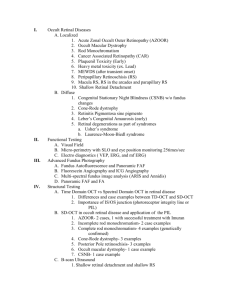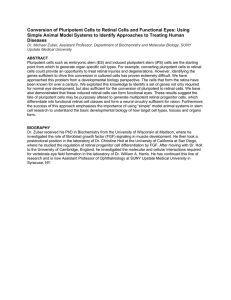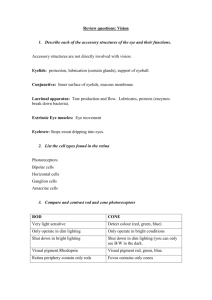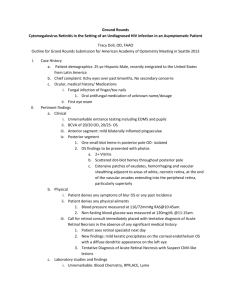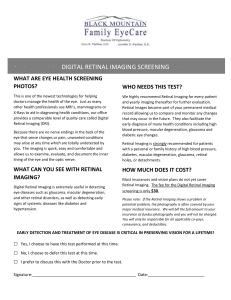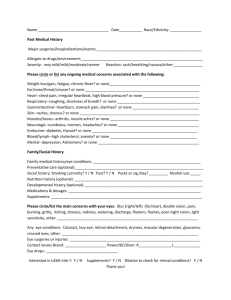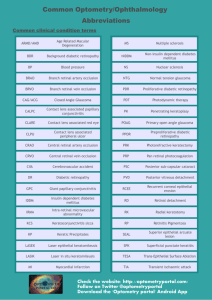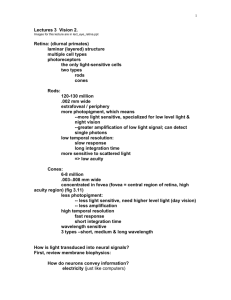Retinal
advertisement
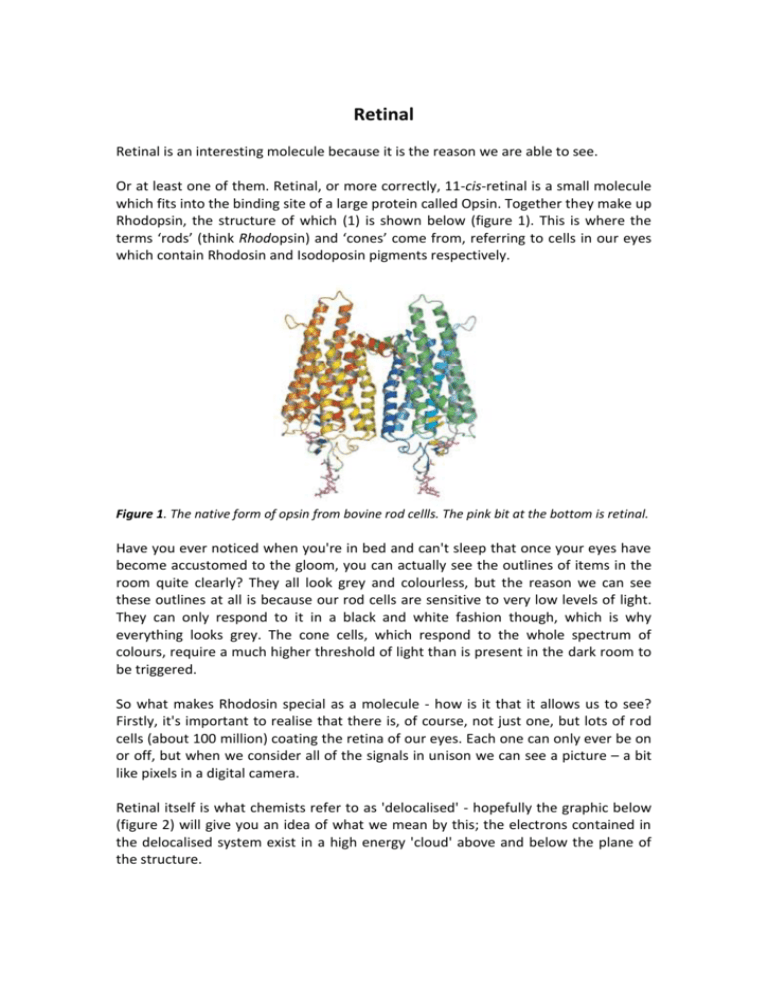
Retinal Retinal is an interesting molecule because it is the reason we are able to see. Or at least one of them. Retinal, or more correctly, 11-cis-retinal is a small molecule which fits into the binding site of a large protein called Opsin. Together they make up Rhodopsin, the structure of which (1) is shown below (figure 1). This is where the terms ‘rods’ (think Rhodopsin) and ‘cones’ come from, referring to cells in our eyes which contain Rhodosin and Isodoposin pigments respectively. Figure 1. The native form of opsin from bovine rod cellls. The pink bit at the bottom is retinal. Have you ever noticed when you're in bed and can't sleep that once your eyes have become accustomed to the gloom, you can actually see the outlines of items in the room quite clearly? They all look grey and colourless, but the reason we can see these outlines at all is because our rod cells are sensitive to very low levels of light. They can only respond to it in a black and white fashion though, which is why everything looks grey. The cone cells, which respond to the whole spectrum of colours, require a much higher threshold of light than is present in the dark room to be triggered. So what makes Rhodosin special as a molecule - how is it that it allows us to see? Firstly, it's important to realise that there is, of course, not just one, but lots of rod cells (about 100 million) coating the retina of our eyes. Each one can only ever be on or off, but when we consider all of the signals in unison we can see a picture – a bit like pixels in a digital camera. Retinal itself is what chemists refer to as 'delocalised' - hopefully the graphic below (figure 2) will give you an idea of what we mean by this; the electrons contained in the delocalised system exist in a high energy 'cloud' above and below the plane of the structure. Figure 2. 'Resonance structures' of retinal - the high energy electrons in the double bonds can flow quickly in the course shown by the arrows. In real-time, retinal exists as a 'resonance hybrid' (bottom) of the left- and right-hand structures. When a light particle (photon) hits retinal, the double bond at the 11 position changes conformation from -cis to -trans (figure 3). You can see from the figure that this changes the shape of the molecule: it photoisomerises. This means it can no longer fit into the cleft into the protein. With retinal no longer stuffed into it, we can think of the protein 'relaxing', and what happens next is what's known as an enzyme cascade. In other words, the relaxation of the protein sets off a complex series of events which ultimately lead to nerves in your brain firing and you seeing an image. Figure 3. 11-cis-retinal changes shape when it absorbs a photon. The –cis prefix comes from the fact that one of the double bonds (at the 11th carbon) has the two largest substituents (that is, the largest chains coming off it) on the same side. The other double bonds are all – trans, or with the bulky substituents positioned on opposite sides. A more modern nomenclature uses the letters E (from the German, entgegen; apart) and Z (from zusammen; together). Retinal is part of a group of retinoids including retinol (aka vitamin A) and their parent molecule beta cartotene (figure 4). These compounds are not made in animals, but plants produce lots of them. Interestingly olives, which are distinctly not orange, also contain high concentrations of these molecules (2). This is where the old saying ‘carrots help you see in the dark’ comes from - unless humans get enough retinoids in their diets, they cease to be able to produce retinal. This can result in conditions like the scary sounding ‘night blindness.’ Relax though: this is hard to contract on a sensible diet. Figure 4. The retinoids retinal, retinol and beta-carotene (so called because it gives carrots their intense orange colour) are all inter-linked by biosynthetic pathways. NADPH is a biological source of negatively charged hydrogen (hydride). You may be scrathing your head at this point, thinking, 'where have I been hearing about retinol recently?' Well, since L'Oreal have recently been inundating us with reports of how wonderful Pro-retinol A, their latest miracle skin cream is, this is probably not suprising. These pro-retinols (can be read as before retinols) break down to retinol on exposure to the skin. Vitamin A itself is what does all the work - it is a chemical messenger, one function of which is to instruct cells to begin multiplying more uniformly, and to produce more elastin and collagen: two protein building materials essential in healthy, young-looking skin cells. I will make no further comment about anti-ageing creams however. Largely because if you're the sort of person who's concerned about whether skin creams are really worth the money (as opposed to assuming they aren't), you're probably not the sort to be reading molecule of the month anyway. References (1) O. P. Ernst et al., Nature, 2008, 454, 183 – 187. (2) http://www.lenntech.com/fruit-vegetable-vitamin-content.htm (Accessed 27.02.2009)



